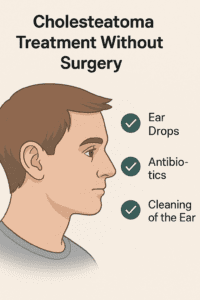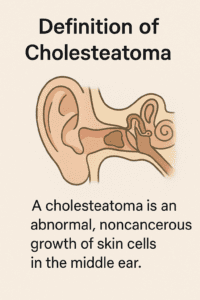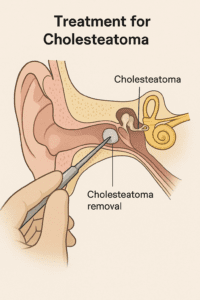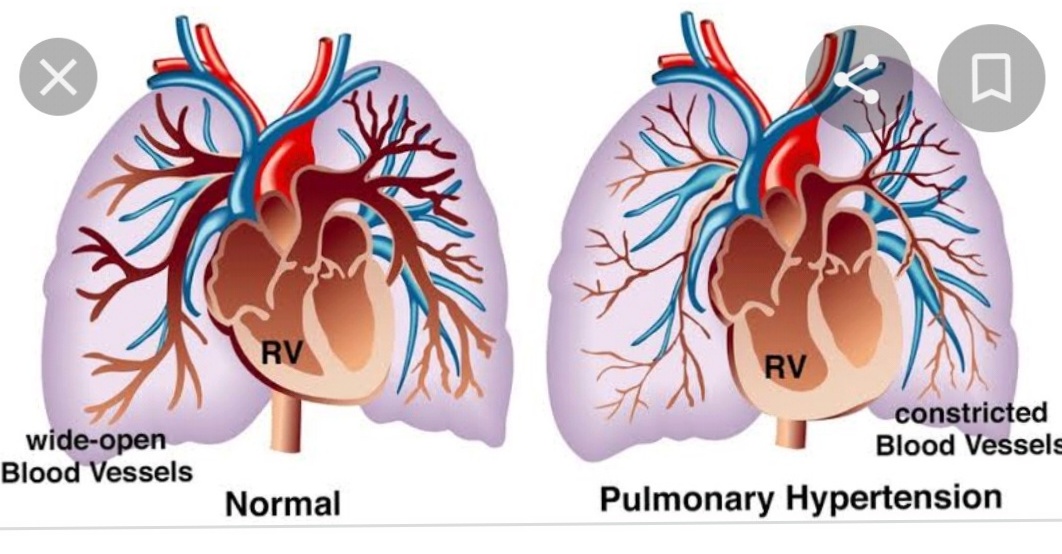Can Cholesteatoma Be Treated Without Surgery? ENT Specialist Explains
Cholesteatoma treatment without surgery
Although surgery is the main and best therapy for cholesteatoma, non-surgical methods can assist regulate the disease and slow its progression, particularly when surgery is not possible right away. These include using antibiotics to treat infection and cleaning the ear to get rid of dirt.


The following is a more thorough examination:
Non-surgical Approaches:
Ear Cleaning (Debridement):
The development and spread of the cholesteatoma can be regulated by removing debris and skin cells from the ear canal and middle ear. With regular inspections, this is frequently done in an office environment.
Antibiotics:
Infections linked to cholesteatoma can be treated with topical and/or systemic antibiotics.
Follow-up closely:
To monitor the progression of the cholesteatoma and modify the course of therapy as necessary, frequent follow-up sessions and routine monitoring are essential.
When Non-Surgical Therapy May Be Considered:
Medical Contraindications:
Non-surgical methods may be used to treat a patient’s ailment if their medical issues render surgery excessively dangerous.
Patient choices:
Patients may occasionally want to avoid surgery or may require time to get ready for it.
Controlling Infection:
Non-surgical therapies may be successful at managing infection and preventing additional problems.
Postponing the operation:
Nonsurgical therapy might give time while a patient’s general health gets better or a better surgical course is decided.
Key Considerations:
Not a Remedy:
Cholesteatoma cannot be cured by nonsurgical procedures. Although they can aid in controlling the illness, they do not halt the course of the illness if left untreated.
Surgery is Still Necessary for Removal:
In the end, surgery is often necessary to eradicate the cholesteatoma and avoid long-term consequences.
Possibility of Recurrence:
Regular follow-up is necessary since there is still a chance of recurrence even after surgery.
In conclusion, although surgery is the gold standard treatment for cholesteatoma, non-surgical therapies such as ear cleaning and antibiotics can help manage the illness and, in some cases, postpone or avoid surgery.
Definition of Cholesteatoma
A cholesteatoma is a cyst or aberrant skin growth that is not cancerous and can occur behind the eardrum. Repeated middle ear infections and impaired eustachian tube function are the main causes, though a birth defect (congenital cholesteatoma) can seldom be the cause.


The eustachian tube connects the middle ear to the nasopharynx (the region at the back of the nasal cavity) in order to facilitate fluid drainage and pressure equalization. A vacuum might develop and cause the tympanic membrane (eardrum) to bulge and form a sac if the tube becomes blocked by an infection or allergy. This sac can collect skin cells, which can eventually develop into a cholesteatoma. Primary acquired cholesteatoma is another name for this.
Past infections or trauma might also cause a cholesteatoma to develop behind a tympanic membrane perforation. Skin cells may migrate through the hole into the middle ear and create a cyst. This is referred to as secondary acquired cholesteatoma.
The erosive enzymes produced by a cholesteatoma can continue to grow and harm the inner ear’s delicate bones if left untreated. These enzymes can also cause infection to spread to surrounding areas. If left unattended for a long time, other significant problems may develop. These could include:
- Infection of the inner ear
- facial muscle paralysis
- Being deaf
- A brain abscess
- Meningitis
Although the aforementioned problems are uncommon, it’s crucial to see your ENT specialist if you have any indications or symptoms of a cholesteatoma.
DISCLAIMER-Some patients go to net and directly take treatment from there which can lead to catastrophic consequences-Then- Many people ask then why to read all this text -the reason is that it helps you to understand the pathology better ,you can cooperate with treatment better ,your treating physician is already busy with his patients and he does not have sufficient time to explain you all the things right from ABCD ,so it is always better to have some knowledge of the disease /disorder you are suffering from.
Symptoms and Signs of Cholesteatoma
If neglected and not identified, cholesteatomas might manifest the following signs, even if they are occasionally asymptomatic:
- one ear discharging (frequently foul-smelling)
- discomfort in the back of the ear
- hearing loss due to conduction
- Tinnitus, which manifests as a ringing or “whooshing” sound in the ear,
- Vertigo


Infection that usually develops as the cholesteatoma grows is the source of the discharge. As the cyst extends from the tympanic membrane and deeper into the middle ear, it can also cause discomfort and tinnitus in the ear.
The enzymes released by the cholesteatoma may, in extreme circumstances, erode the bones in the surrounding area. The delicate, little bones in the middle ear (ossicles) that carry vibrations from the tympanic membrane to the cochlea, where the vibrations are processed and transmitted to the auditory nerve, may be harmed by this. Hearing loss might result from damage to the ossicles.
Additionally, the enzymes can weaken the thin bone wall that surrounds the cochlea, resulting in an inner ear infection. Since the cochlea is also in charge of equilibrium, an infection in this area may result in vertigo or dizziness.
Finding a Cholesteatoma
Based on the first indications, your health care practitioner may believe you have an ear infection during the first checkup. Antibiotic treatment might not be successful in relieving the symptoms. Your provider may see a crust in the top section of the middle ear (the attic) during a subsequent evaluation. The tympanic membrane could be perforated or not.
To ascertain the extent of hearing loss (if any), a hearing test, often referred to as an audiogram, is usually conducted. Additionally, a balance test can be conducted to determine if the cyst is the source of any balance problems.
A CT (computed tomography) scan may be requested to evaluate the degree of bone damage caused by the cholesteatoma if it is suspected that it has done so. If bone injury leading to the skull is apparent, an MRI (magnetic resonance imaging) may also be ordered to check for any problems in the intracranial space, such as an abscess.
Treatment for Cholesteatoma
Antibiotics may cure the underlying illness caused by a cholesteatoma, but if the cyst itself is not removed, the symptoms are likely to return. In rare cases, if the cyst is small enough, it may be treated without surgery using antibiotic drops and frequent, expert cleaning. But in most cases, the cyst has to be taken out through surgery.
A tympanomastoidectomy involves both the removal of the infected bone tissue and the repair of the tympanic membrane. To reach the middle ear, an incision is made behind the ear, and the ear is pulled forward to reveal the bone underneath. During this stage, the cholesteatoma and the contaminated bone tissue are removed. The tympanic membrane is then reconstructed using muscle lining that was preserved during the original incisions to reveal the bone behind the ear.


During the operations, care is also taken to safeguard the ossicles, but if they are severely injured, it may be necessary to remove them. If necessary, they can be fixed or replaced in a future operation using prosthetics or real bone.
Most cholesteatoma surgeries are performed under general anesthesia. It’s rarely done with a local anesthetic and sedation. Patients are typically able to return home the same day after surgery, which lasts two to three hours. To completely recover, patients should anticipate taking one to two weeks off from school or work.
During this time, strenuous exercise should also be avoided. Avoid any actions that might put pressure on your ears. These events include, but are not limited to:
- Swimming
- Diving
- Flying
- Contact sports
- lifting heavy objects
- Hard physical activity
Where to Find Assistance for Cholesteatoma
Call Prabha ENT clinic to arrange a visit or click here to “find an ENT doctor near me in” if you’re experiencing any or all of the symptoms listed above and think you may have a cholesteatoma.
If any patient has any ENT -Ear nose throat problems and requires any , consultation ,online consultation ,or surgery in clinic of ENT specialist Doctor Dr Sagar Rajkuwar ,he may TAKE APPOINTMENT BY CLICKING ON THE LINK GIVEN BELOW-
Clinic address of ENT SPECIALIST doctor Dr Sagar Rajkuwar-
Prabha ENT clinic, plot no 345,Saigram colony, opposite Indoline furniture Ambad link road ,Ambad ,1 km from Pathardi phata Nashik ,422010 ,Maharashtra, India-Dr Sagar Rajkuwar (MS-ENT), Cel no- 7387590194 , 9892596635




